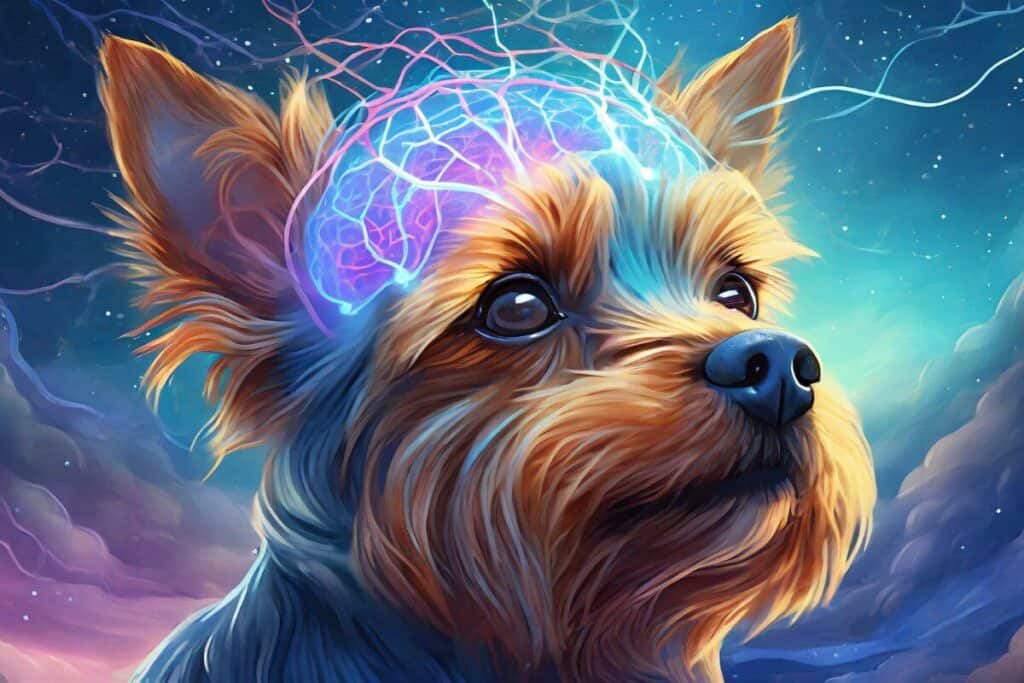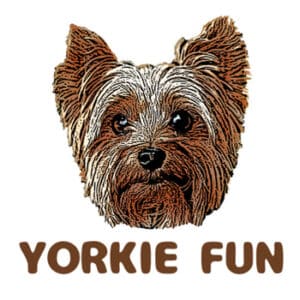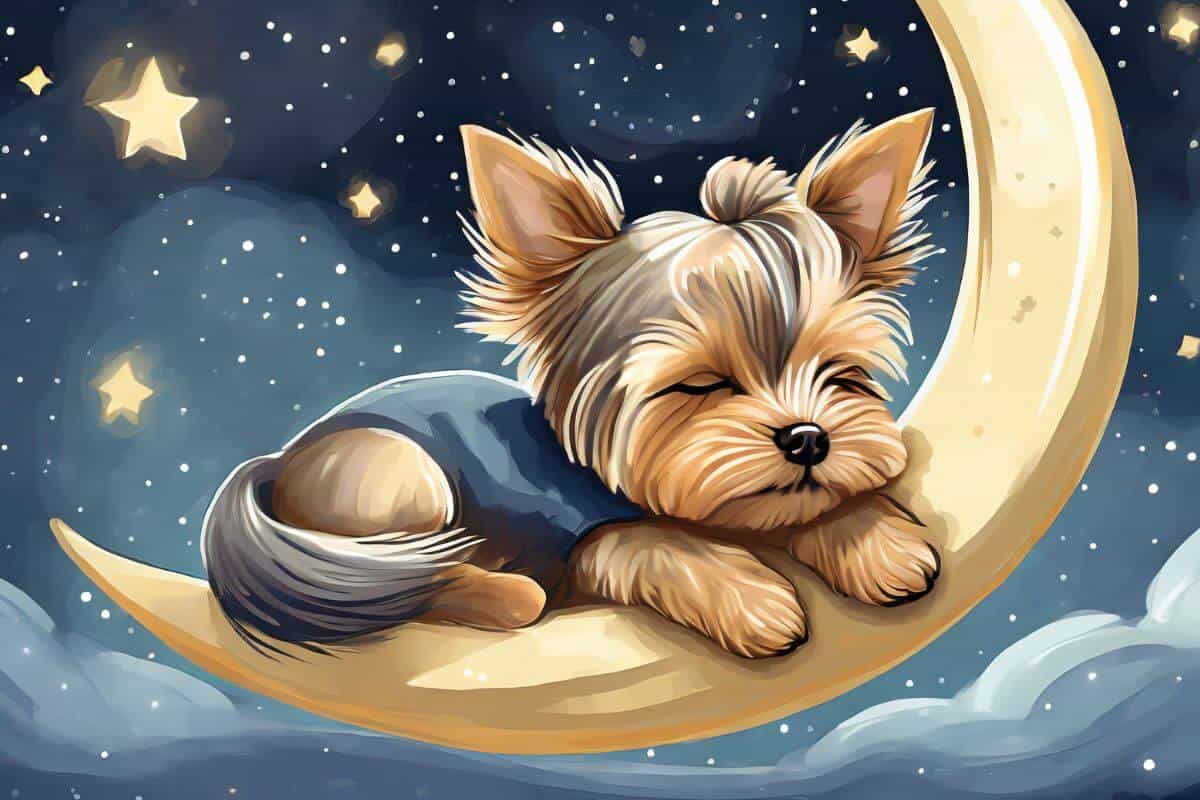You’ve noticed your Yorkie twitching during sleep, and it’s left you puzzled and concerned. You’re not alone in this observation, and we understand your worry. Rest assured, we’ve delved deep into this topic and have the answers you’re seeking.
Dogs often twitch in their sleep due to natural dream cycles, specifically during the REM (rapid eye movement) stage. This twitching is a common and mostly harmless behavior, indicating that your pet might be dreaming or processing their day.
But there’s so much more to uncover about this intriguing behavior. From the science behind canine dreams to distinguishing between harmless twitches and potential health concerns, we have a wealth of information ahead. Stay with us to ensure your Yorkie’s well-being and satisfy your curiosity!
Understanding the Twitch: The Science Behind Your Yorkie’s Sleep Movements

Every pet owner has, at some point, observed their furry friend twitching, moving, or even vocalizing during sleep. It’s a sight that can be both endearing and puzzling. So, why does your Yorkie twitch in his sleep? Let’s dive deep into the science of it.
Dogs, much like humans, have complex sleep patterns. They cycle through various stages of sleep, the most intriguing of which is the REM (Rapid Eye Movement) stage. This is the phase where most of the dreaming occurs. When your Yorkie twitches, it’s a strong indication that he’s deep in a dream. Imagine him chasing a butterfly or playing with his favorite toy in a dreamy meadow!
- NREM (Non-Rapid Eye Movement): This is the initial phase where your dog starts to drift into slumber. It’s a light sleep stage.
- REM (Rapid Eye Movement): As mentioned, this is the dream stage. The brain is highly active, almost akin to when it’s awake. This activity translates to those adorable twitches you notice.
- SWS (Short-Wave Sleep): This is the deep sleep phase. Your dog’s body is relaxed, and he’s least responsive to external stimuli.
The brain activity during the REM stage is fascinating. The brain sends signals throughout the body, but because of a mechanism in the brain stem, these signals don’t translate into significant movements. This mechanism ensures your Yorkie doesn’t actually “act out” his dreams. However, minor signals escape this mechanism, leading to the twitches we observe.
In a fascinating study conducted by the Massachusetts Institute of Technology (MIT) in 2001, researchers delved into the dream patterns of animals. They observed laboratory rats that had been trained to navigate a maze. Remarkably, during their REM (Rapid Eye Movement) sleep, these rats exhibited brain activity strikingly similar to when they were actively running the maze. This led the scientists to conclude that the rats were, in fact, dreaming about their earlier maze adventures. Such findings offer intriguing insights into the dream behaviors of animals, shedding light on why our beloved Yorkies might twitch and move during their sleep. (Source)
If you’ve ever wondered whether the twitching is a cause for concern, in most cases, it’s not. It’s a natural part of the sleep cycle. However, it’s always good to be observant. If the twitching is excessive or accompanied by other unusual behaviors, it might be worth a vet visit.
As we journey further into the world of canine sleep, you’ll discover there’s so much more to these nighttime behaviors. From the dreams they might have to the differences in sleep patterns across ages, let’s uncover the mysteries of your Yorkie’s sleep.
Dreaming Dogs: A Deep Dive into Canine Dream States
Ever watched your Yorkie snoozing and wondered, “What’s he dreaming about?” Just like us, dogs have dreams, too! And while we can’t exactly ask them about their nightly adventures, science gives us some cool clues.
The Sleep Stages of Dogs:
- NREM (Non-Rapid Eye Movement): This is the chill phase. It’s when your Yorkie starts to drift into dreamland, but he’s still in a light sleep. Think of it as the intro scene of a movie.
- REM (Rapid Eye Movement): This is where the action happens! It’s the dream stage. If your Yorkie’s a superhero in his dreams, this is when he’s saving the day. Those tiny twitches? They’re part of this stage.
- SWS (Short-Wave Sleep): This is the deep, restful sleep. Your Yorkie’s body is super relaxed, and he’s recharging for more playtime tomorrow.
Table: Canine Sleep Stages and Their Characteristics
| Sleep Stage | Description | What’s Happening in Yorkie’s Dreams? |
|---|---|---|
| NREM (Non-Rapid Eye Movement) | The chill phase where Yorkies drift into light sleep. | Think of it as the intro scene of a movie. |
| REM (Rapid Eye Movement) | The action-packed dream stage. | This is when your Yorkie might be a superhero, saving the day. Those tiny twitches? They’re dream reactions. Brain activity during this phase is similar to when a dog is awake. |
| SWS (Short-Wave Sleep) | The deep, restful sleep phase. | Your Yorkie is super relaxed, recharging for the next day’s adventures. Most dogs have a preferred sleep position during this phase. |
Now, you might be thinking, “Why do dogs even dream?” Great question! Just like humans, dogs process their day during sleep. So, if your Yorkie had a fun day chasing balls, he might be reliving those moments in his dreams. And those twitches? They’re like little sneak peeks into his dream world.
But here’s a fun fact: The size of a dog can influence their dream frequency. Smaller breeds, like Yorkies, tend to dream more often than larger breeds. So, if you’ve ever felt that your little furball has more dreamy adventures, you’re spot on!
Dreams are a natural part of a dog’s sleep cycle. They’re a sign that your Yorkie’s brain is active and healthy. So, the next time you see him twitching or “running” in his sleep, just smile and think of the wonderful dreams he might be having.
Here’s a cute video that talks about NREM, REM, and SWS in a fun way:
But wait, there’s more to this sleep saga! How does age influence these dream patterns? And why do puppies and older dogs seem to twitch more? Let’s dive into the next chapter and unravel these mysteries.
Age Matters: Why Puppies and Senior Dogs Twitch More
Age isn’t just a number for our furry friends and their dreamy adventures. Just like kids have different sleep habits than grandparents, puppies, and senior dogs have their own unique sleep quirks. Let’s explore!
Puppies (0-1 year)
- Oh, the energy of a puppy! They play hard, and guess what? They sleep hard, too. Puppies need loads of sleep, almost like they have a sleep button that’s always on.
- But here’s the fun part: When they’re not zooming around, they often dream about it. Those little paws twitching? Maybe he’s dreaming of chasing his tail or playing with his squeaky toy.
Adults (1-7 years)
- Adult Yorkies have found their groove. They’ve got a balance between playtime, naptime, and dreamtime.
- Their dreams might be more “mature” now. Instead of dreaming about puppy school, maybe they’re dreaming about that epic park adventure or the squirrel that got away.
Seniors (8+ years)
- Senior dogs, with their wise whiskers and gentle eyes, have seen a lot. And they have a treasure trove of memories to dream about.
- They might sleep a bit more, just like Grandpa in his favorite armchair. And with age, they might twitch more in their dreams, reminiscing about their youthful escapades.
Table: Sleeping Patterns of Yorkies by Age
| Age Group | Average Sleep (Hours per Day) | REM Cycle Characteristics | Observations on Twitching |
|---|---|---|---|
| Puppies (0-1 year) | 18-20 hours | Frequent but shorter | More observable twitching due to frequent REM cycles. |
| Adults (1-7 years) | 12-14 hours | Established and longer | Less twitching as REM cycles are fewer but longer. |
| Seniors (8+ years) | 14-16 hours | Variable | Increased twitching, similar to puppies. |
Isn’t it fascinating how age shapes our Yorkies’ sleep and dreams? From the boundless energy of puppies to the serene slumbers of seniors, each phase has its charm. And those twitches? They’re like secret whispers from their dream world.
But there’s another layer to this story. Not all twitches are dreamy dances. External factors might influence some. Curious about what might be causing those extra twitches on a stormy night or a sunny afternoon nap? Let’s dive deeper and uncover the external triggers of your Yorkie’s sleep twitches.
Decoding the External Triggers: Factors Influencing Sleep Twitching
Ever noticed that sometimes your Yorkie twitches more on certain days or in specific situations? It’s not just random; external factors can play a big role in how our furry pals dream and twitch. Let’s play detective and uncover these external mysteries!
Sleeping Positions
- Curled Up: Many Yorkies love curling up like a little donut. It’s cozy and warm. But did you know this position might lead to more twitching? It’s like they’re in a tight ball of dreamy energy!
- Stretched Out: When stretched out, Yorkies might twitch less. They’re all relaxed, letting their dreams flow smoothly without much movement.
Noises and Sounds
- Thunderstorms: Boom! Crash! Thunder can make some Yorkies twitch more in their sleep. Maybe they’re dreaming of chasing the loud noises away.
- Everyday Sounds: The doorbell, a car honking, or even a bird chirping can sneak into their dreams. These sounds might make them twitch as they react in their dream world.
Temperature Changes
- Warm and Cozy: On a cold day, if your Yorkie’s snuggled up in a warm spot, he might sleep deeper and twitch less.
- Hot and Toasty: On the flip side, if it’s too warm, he might have restless dreams, leading to more twitching.
It’s like our Yorkies have their own dream language, influenced by the world around them. These external triggers give us a sneak peek into how they perceive their environment, even in their sleep.
But here’s a twist! Not all twitches are just dream dances or reactions to the environment. Some might look similar but have a different cause. How do we distinguish between a dreamy twitch and something more serious, like a seizure? Let’s dive into the next section and learn how to distinguish between dreaming and potential health concerns.
Dream or Distress? Distinguishing Between Dreaming and Seizures
Watching your Yorkie twitch in sleep can be cute, but what if it’s not just a dream? Sometimes, those movements might hint at something more serious. Let’s learn how to tell the difference between a harmless dream dance and a potential health concern.
Dreamy Twitches
- Duration: Dream twitches are usually short-lived. They come and go like little bursts of energy.
- Movements: These twitches can be anything from a tiny wiggle of the nose to a gentle kick of the leg. It’s like they’re acting out a fun scene from their dream.
Seizure Signs
- Duration: Seizures tend to last longer. If your Yorkie’s twitching or shaking continues for several minutes, it might be a cause for concern.
- Intensity: Unlike the gentle dream twitches, seizures can be more intense. You might notice rigid muscles, drooling, or even a loss of consciousness.
- After Effects: Post-seizure, dogs might seem disoriented or even temporarily blind. They could be wobbly on their feet or seem unusually tired.
It’s essential to be observant. While most of the time, your Yorkie’s movements in sleep are just adorable dream antics, it’s good to know the signs of something more serious. If you ever feel unsure, it’s always best to consult with your vet. They can provide guidance and ensure your furry friend’s well-being.
But don’t let this worry you too much! Most of the time, our Yorkies just have fun in their dream world. And speaking of dreams, ever wondered what other sleep behaviors your Yorkie might exhibit? From vocalizing to eye movements, let’s dive deeper into the world of canine sleep behaviors in our next section.
Beyond the Twitch: Other Sleep Behaviors and What They Mean
So, we’ve talked about the twitches, but what about those little barks, whimpers, or even the rapid eye movements behind those closed eyelids? Our Yorkies have a whole world of sleep behaviors that are both fascinating and adorable. Let’s embark on this dreamy journey and discover what these behaviors reveal!
Vocalizing in Dreams
- Little Barks: Ever heard a soft bark or two while your Yorkie’s deep in slumber? Maybe he’s being the neighborhood hero, chasing away imaginary intruders in his dreams.
- Whimpers and Whines: These sounds tug at our heartstrings. Your Yorkie might be having a not-so-fun dream or perhaps missing you in his dream world.
Eye Movements
- Rapid Movements: Just like humans have Rapid Eye Movement (REM) sleep, dogs do too! If you see your Yorkie’s eyes darting behind closed lids, he’s probably in the REM stage, dreaming away.
- Slow Rolls: Sometimes, their eyes might roll slowly. It’s a sign of deep relaxation and a peaceful dream state.
Tail and Ear Twitches
- Tail Wagging: A wagging tail even in sleep? Your Yorkie might have a happy dream, perhaps playing in a field full of treats!
- Ear Flicks: Those tiny ear movements could indicate that he’s listening to something interesting in his dream, maybe the call of a dreamy adventure.
Our Yorkies’ sleep behaviors are like a window into their dream world. Each twitch, bark, or eye movement tells a story, making bedtime an enchanting experience.
But while these behaviors are mostly harmless and endearing, it’s essential to know when something might be amiss. From external factors to potential health concerns, understanding our pets’ sleep behaviors ensures their well-being. Ready to dive deeper? Let’s explore the external factors that might influence your Yorkie’s dreamy twitches in the next section.
Dreamy Tails and Sleepy Tales: Wrapping Up the Yorkie Nighttime Saga
What a journey through the dreamy world of our Yorkies! From understanding the science behind those adorable twitches to diving deep into canine dream states, we’ve unraveled the mysteries of Yorkie sleep. We’ve discovered that age plays a role in their dream patterns, with puppies and seniors stealing the twitchy spotlight. External factors, like a thunderstorm or a cozy blanket, can influence their dream dances. And while most of these nighttime behaviors are just glimpses into their dream adventures, it’s always good to be observant and ensure our furry pals are in the pink of health.
So, the next time you see your Yorkie twitching, barking, or even “running” in his sleep, just smile. Imagine the grand adventures he’s having in his dream world. After all, every twitch is a tale, and every dream is a story waiting to be told. Sweet dreams to your Yorkie and to you!


